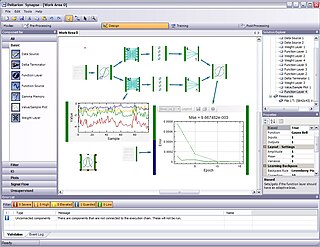
Artificial neural networks are a branch of machine learning models that are built using principles of neuronal organization discovered by connectionism in the biological neural networks constituting animal brains.
Computer science is the study of the theoretical foundations of information and computation and their implementation and application in computer systems. One well known subject classification system for computer science is the ACM Computing Classification System devised by the Association for Computing Machinery.
Bio-inspired computing, short for biologically inspired computing, is a field of study which seeks to solve computer science problems using models of biology. It relates to connectionism, social behavior, and emergence. Within computer science, bio-inspired computing relates to artificial intelligence and machine learning. Bio-inspired computing is a major subset of natural computation.
The expression computational intelligence (CI) usually refers to the ability of a computer to learn a specific task from data or experimental observation. Even though it is commonly considered a synonym of soft computing, there is still no commonly accepted definition of computational intelligence.

A neural network can refer to either a neural circuit of biological neurons, or a network of artificial neurons or nodes in the case of an artificial neural network. Artificial neural networks are used for solving artificial intelligence (AI) problems; they model connections of biological neurons as weights between nodes. A positive weight reflects an excitatory connection, while negative values mean inhibitory connections. All inputs are modified by a weight and summed. This activity is referred to as a linear combination. Finally, an activation function controls the amplitude of the output. For example, an acceptable range of output is usually between 0 and 1, or it could be −1 and 1.

A multilayer perceptron (MLP) is a fully connected class of feedforward artificial neural network (ANN). The term MLP is used ambiguously, sometimes loosely to mean any feedforward ANN, sometimes strictly to refer to networks composed of multiple layers of perceptrons ; see § Terminology. Multilayer perceptrons are sometimes colloquially referred to as "vanilla" neural networks, especially when they have a single hidden layer.

David Everett Rumelhart was an American psychologist who made many contributions to the formal analysis of human cognition, working primarily within the frameworks of mathematical psychology, symbolic artificial intelligence, and parallel distributed processing. He also admired formal linguistic approaches to cognition, and explored the possibility of formulating a formal grammar to capture the structure of stories.
The Predictive Model Markup Language (PMML) is an XML-based predictive model interchange format conceived by Dr. Robert Lee Grossman, then the director of the National Center for Data Mining at the University of Illinois at Chicago. PMML provides a way for analytic applications to describe and exchange predictive models produced by data mining and machine learning algorithms. It supports common models such as logistic regression and other feedforward neural networks. Version 0.9 was published in 1998. Subsequent versions have been developed by the Data Mining Group.

Emergent is a neural simulation software that is primarily intended for creating models of the brain and cognitive processes. Development initially began in 1995 at Carnegie Mellon University, and as of 2014, continues at the University of Colorado at Boulder. The 3.x release of the software, which was known as PDP++, is featured in the textbook Computational Explorations in Cognitive Neuroscience.

Synapse is a component-based development environment for neural networks and adaptive systems. Created by Peltarion, Synapse allows data mining, statistical analysis, visualization, preprocessing, design and training of neural networks and adaptive systems and the deployment of them. It utilizes a plug-in based architecture making it a general platform for signal processing. The first version of the product was released in May 2006.

Waikato Environment for Knowledge Analysis (Weka) is a collection of machine learning and data analysis free software licensed under the GNU General Public License. It was developed at the University of Waikato, New Zealand and is the companion software to the book "Data Mining: Practical Machine Learning Tools and Techniques".

NeuroSolutions is a neural network development environment developed by NeuroDimension. It combines a modular, icon-based (component-based) network design interface with an implementation of advanced learning procedures, such as conjugate gradients, the Levenberg-Marquardt algorithm, and backpropagation through time. The software is used to design, train and deploy neural network models to perform a wide variety of tasks such as data mining, classification, function approximation, multivariate regression and time-series prediction.
Interactive activation and competition (IAC) networks are artificial neural networks used to model memory and intuitive generalizations. They are made up of nodes or artificial neurons which are arrayed and activated in ways that emulate the behaviors of human memory.
GENESIS is a simulation environment for constructing realistic models of neurobiological systems at many levels of scale including: sub-cellular processes, individual neurons, networks of neurons, and neuronal systems. These simulations are “computer-based implementations of models whose primary objective is to capture what is known of the anatomical structure and physiological characteristics of the neural system of interest”. GENESIS is intended to quantify the physical framework of the nervous system in a way that allows for easy understanding of the physical structure of the nerves in question. “At present only GENESIS allows parallelized modeling of single neurons and networks on multiple-instruction-multiple-data parallel computers.” Development of GENESIS software spread from its home at Caltech to labs at the University of Texas at San Antonio, the University of Antwerp, the National Centre for Biological Sciences in Bangalore, the University of Colorado, the Pittsburgh Supercomputing Center, the San Diego Supercomputer Center, and Emory University.
Biology data visualization is a branch of bioinformatics concerned with the application of computer graphics, scientific visualization, and information visualization to different areas of the life sciences. This includes visualization of sequences, genomes, alignments, phylogenies, macromolecular structures, systems biology, microscopy, and magnetic resonance imaging data. Software tools used for visualizing biological data range from simple, standalone programs to complex, integrated systems.
Network of human nervous system comprises nodes that are connected by links. The connectivity may be viewed anatomically, functionally, or electrophysiologically. These are presented in several Wikipedia articles that include Connectionism, Biological neural network, Artificial neural network, Computational neuroscience, as well as in several books by Ascoli, G. A. (2002), Sterratt, D., Graham, B., Gillies, A., & Willshaw, D. (2011), Gerstner, W., & Kistler, W. (2002), and Rumelhart, J. L., McClelland, J. L., and PDP Research Group (1986) among others. The focus of this article is a comprehensive view of modeling a neural network. Once an approach based on the perspective and connectivity is chosen, the models are developed at microscopic, mesoscopic, or macroscopic (system) levels. Computational modeling refers to models that are developed using computing tools.

This glossary of artificial intelligence is a list of definitions of terms and concepts relevant to the study of artificial intelligence, its sub-disciplines, and related fields. Related glossaries include Glossary of computer science, Glossary of robotics, and Glossary of machine vision.










